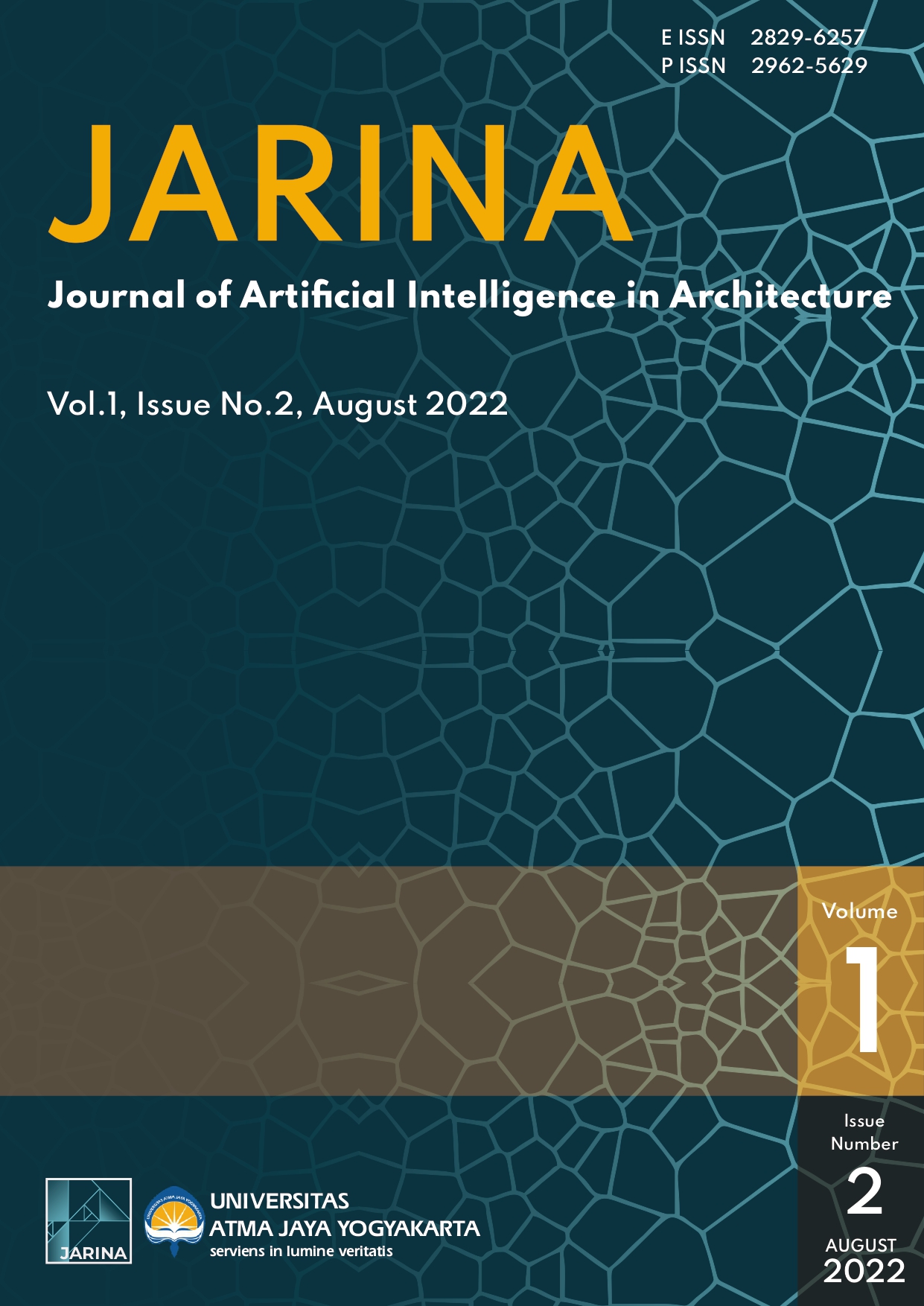The Development of Tuberculosis Treatment Room in Humid Tropical Climate
DOI:
https://doi.org/10.24002/jarina.v1i2.5720Keywords:
CFD, Tuberculosis, Nosocomial, Treatment RoomAbstract
Developing countries with a humid tropical climate, such as Indonesia, still have a severe problem with Tuberculosis (TB). Mycobacterium tuberculosis (MTB) mainly causes TB and is transmitted through droplets released by active TB patients into the air that progress faster in humid tropical climates. Health workers are at high risk of contracting TB bacteria from TB patients because nosocomial infections (healthcare-associated infections) categorize as TB. Public Health Centers usually provide generic rooms but are not explicitly designed to minimize TB infections. The Indonesian government does not offer a TB treatment room design, so this research developed a Tuberculosis Treatment Room (TBTR) prototype using a computational fluid dynamics simulation. The TBTR prototype was split into medicine and sputum room. The simulation showed that the TBTR's air change per hour was between 77 and 94, far above the minimum standard of 12. In addition, TBTR showed indoor air 80cm above the floor flowed upward and out through the ceilings, while indoor air below 40cm above the floor flowed through lower openings. Those ventilation mechanisms expelled the indoor bacteria out and minimized infection
References
R. Reviono, W. Setianingsih, K. E. Damayanti, and R. Ekasari, “The dynamic of tuberculosis case finding in the era of the public–private mix strategy for tuberculosis control in Central Java, Indonesia,” Glob. Health Action, vol. 10, no. 1, 2017, doi: 10.1080/16549716.2017.1353777.
Depkes, Pedoman Pencegahan Dan Pengendalian Infeksi Tuberkulosis Di Fasilitas Pelayanan Kesehatan. Jakarta: Kementerian Kesehatan Republik Indonesia Direktorat Bina Upaya Kesehatan, 2012.
C. Dewi, L. Barclay, M. Passey, and S. Wilson, “Improving knowledge and behaviours related to the cause, transmission and prevention of Tuberculosis and early case detection: A descriptive study of community led Tuberculosis program in Flores, Indonesia,” BMC Public Health, vol. 16, no. 1, pp. 1–13, 2016, doi: 10.1186/s12889-016-3448-4.
A. Probandari et al., “The path to impact of operational research on tuberculosis control policies and practices in Indonesia,” Glob. Health Action, vol. 9, no. 1, 2016, doi: 10.3402/gha.v9.29866.
C. Basri, K. Bergström, W. Walton, A. Surya, J. Voskens, and F. Metha, “Sustainable scaling up of good quality health worker education for tuberculosis control in Indonesia: A case study,” Hum. Resour. Health, vol. 7, pp. 1–10, 2009, doi: 10.1186/1478-4491-7-85.
R. A. Ahmad et al., “Diagnostic work-up and loss of tuberculosis suspects in Jogjakarta, Indonesia,” BMC Public Health, vol. 12, no. 1, p. 132, 2012, doi: 10.1186/1471-2458-12-132.
C. Y. Aditama, Tuberkulosis Paru.: Masalah dan penanggulangannya. Jakarta: UI Press.
A. Catanzaro, “Nosocomial Tuberculosis 12 ANTONINO CATANZARO With the technical assistance of Sandra Emerson and Ellen Logue,” pp. 559–562, 1981.
N. Ahmed and S. E. Hasnain, “Molecular epidemiology of tuberculosis in India: Moving forward with a systems biology approach,” Tuberculosis, vol. 91, no. 5, pp. 407–413, 2011, doi: 10.1016/j.tube.2011.03.006.
E. A. Nardell, “Indoor environmental control of tuberculosis and other airborne infections,” Indoor Air, vol. 26, no. 1, pp. 79–87, 2016, doi: 10.1111/ina.12232.
H. Chu et al., “Risk of tuberculosis among healthcare workers in an intermediate-burden country: A nationwide population study,” J. Infect., vol. 69, no. 6, pp. 525–532, 2014, doi: 10.1016/j.jinf.2014.06.019.
Depkes, Pedoman Nasional Pengendalian Tuberkulosis. Jakarta: Kementerian Kesehatan Republik Indonesia Direktorat Jenderal Pengendalian Menular dan Penyehatan Lingkungan Permukiman, 2014.
M. Girsang, “Kesalahan-kesalahan dalam Pemeriksaan Sputum BTA pada Program Penanggulangan TV terhadap beberapa Pemeriksaan dan Identifikasi Penyakit TBC,” Jakarta Media Litbang Kesehat., vol. IX, no. 3, 1999.
Atmosukarto and S. Soewasti, “Pengaruh Lingkungan Pemukiman dalam Penyebaran Tuberkulosis,” Jakarta Media Litbang Kesehat., vol. IX, no. 4, 2000.
N. I. P. Sari, N. M. Mertaniasih, Soedarsono, and F. Maruyama, “Application of serial tests for Mycobacterium tuberculosis detection to active lung tuberculosis cases in Indonesia,” BMC Res. Notes, vol. 12, no. 1, pp. 1–6, 2019, doi: 10.1186/s13104-019-4350-9.
M. Hartono, “Indonesian anthropometry update for special populations incorporating Drillis and Contini revisited,” Int. J. Ind. Ergon., vol. 64, pp. 89–101, 2018, doi: 10.1016/j.ergon.2018.01.004.
Kementrian Kesehatan Republik Indonesia, Peraturan Menteri Kesehatan Republik Indonesia Nomor 27 Tahun 2017 Tentang Pedoman Pencegahan Dan Pengendalian Infeksi Di Fasilitas Pelayanan Kesehatan. Jakarta, 2017.
C. Penner, D. Roberts, D. Kunimoto, J. Manfreda, and R. Long, “Tuberculosis as a primary cause of respiratory failure requiring mechanical ventilation,” Am. J. Respir. Crit. Care Med., vol. 151, no. 3 I, pp. 867–872, 1995, doi: 10.1164/ajrccm.151.3.7881684.
J. W. Tang, Y. Li, I. Eames, P. K. S. Chan, and G. L. Ridgway, “Factors involved in the aerosol transmission of infection and control of ventilation in healthcare premises,” J. Hosp. Infect., vol. 64, no. 2, pp. 100–114, 2006, doi: 10.1016/j.jhin.2006.05.022.
Kementrian Kesehatan Republik Indonesia Direktorat Bina upaya Kesehatan Jakarta, Pedoman Pengendalian TB di Fasyankes. Jakarta, 2012.
U.S. Department of Health & Human Services, “Centers for Disease Control and Prevention.” https://www.cdc.gov/.
ASHRAE, “ASHRAE.” https://www.ashrae.org/technical-resources/standards-and-guidelines/standards-interpretations/interpretations-for-standard-170-2013.
C. M. Issarow, N. Mulder, and R. Wood, “Environmental and social factors impacting on epidemic and endemic tuberculosis: A modelling analysis,” R. Soc. Open Sci., vol. 5, no. 1, 2018, doi: 10.1098/rsos.170726.
M. Santamouris and F. Allard, Natural Ventilation in Buildings: A Design Handbook. London: James & James, 1998.
Published
How to Cite
Issue
Section
License
Copyright (c) 2022 Wisdom Sandjaya Papendang, Samuel Yudhatama

This work is licensed under a Creative Commons Attribution 4.0 International License.
Authors who publish with this journal agree to the following terms:
1.Authors retain copyright and grant the journal right of first publication with the work simultaneously licensed under a Creative Commons that allows others to share the work with an acknowledgement of the work's authorship and initial publication in this journal.
2.Authors are able to enter into separate, additional contractual arrangements for the non-exclusive distribution of the journal's published version of the work (e.g., post it to an institutional repository or publish it in a book), with an acknowledgement of its initial publication in this journal.
3.Authors are permitted and encouraged to post their work online (e.g., in institutional repositories or on their website) prior to and during the submission process, as it can lead to productive exchanges, as well as earlier and greater citation of published work (See The Effect of Open Access).

















